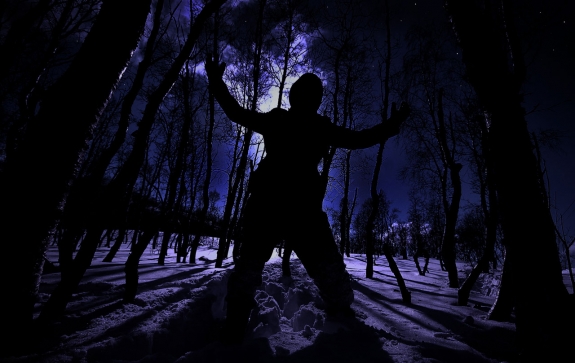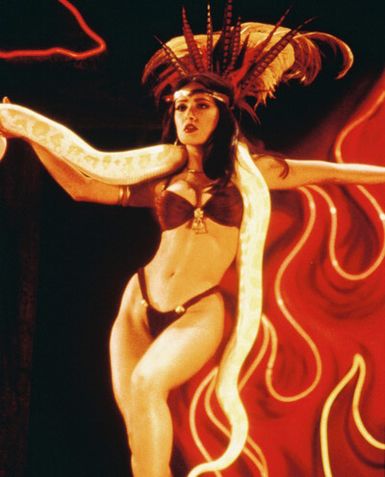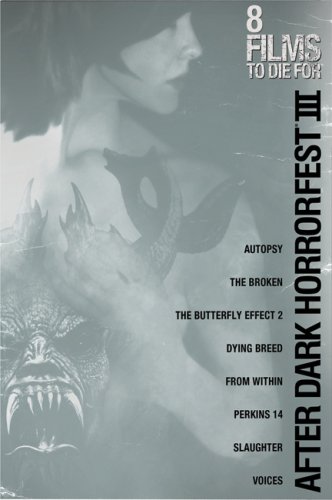 “Zombie Nazis” sounds like an unbeatable combination, but it turns out to be one of those great ideas that cannot sustain itself purely on the concept alone (unlike, say the “Soup Nazi” episode of SEINFELD, which could have earned classic status merely on the basis of its title). Although DEAD SNOW has its heart in the right place (enthusiastically embracing the horror genre, it is eager to please its target audience), in execution it does not quite live up to the brilliance of its own premise; only occasionally does it mixture of horror and hysteria reach critical mass, igniting the explosions of screams and laughter promised by the coming attractions. For horror fans it is worth seeing, but this is one of those examples when the trailer is the movie.
“Zombie Nazis” sounds like an unbeatable combination, but it turns out to be one of those great ideas that cannot sustain itself purely on the concept alone (unlike, say the “Soup Nazi” episode of SEINFELD, which could have earned classic status merely on the basis of its title). Although DEAD SNOW has its heart in the right place (enthusiastically embracing the horror genre, it is eager to please its target audience), in execution it does not quite live up to the brilliance of its own premise; only occasionally does it mixture of horror and hysteria reach critical mass, igniting the explosions of screams and laughter promised by the coming attractions. For horror fans it is worth seeing, but this is one of those examples when the trailer is the movie.
The film starts off with Sara (Ane Dahl Torp) being pursued through the snow by some shadowy shapes that eventually overtake her. We then see her friends driving to an isolated cabin owned by Sara, where they anticipate a weekend of snowboarding. The pristine photography (by Matthew Weston) and the likable performances cue us to expect something really exceptional as DEAD SNOW slowly builds up a head of steam, but instead of creating tension, the long first act gives the audience a chance to slip into its comfort zone.
Not that things get boring. There interaction of the characters is intially engaging: one is a film buff who notes the number of horror films that begin with a group of friends heading out to an isolated cabin (including THE EVIL DEAD and EVIL DEAD II). Unfortunately, hints of sloppy writing emerge: it takes way too long for anyone to worry about Sara’s absence. If you’re going to spend a half-hour making viewers like the characters before they get killed, it’s not a good idea to make them so indifferent to the fate of one of their own.
When the zombies do show up (after a walking mouthpiece – who should have been named Basil Exposition – wanders in just long enough to deliver a brief history lesson of the Nazi occupation of the area), they deliver some entertaining kills, but DEAD SNOW still does not hit its stride until late in the third act, when the gross-out gore turns more overtly comical, and a pair of survivors (including a med student who is afraid of blood) engage the enemy in a bloody battle that leaves many heads, arms, and legs severed – and one penis badly damaged.
In the frenzy of the fight, the fact that our queasy med student has overcome his fear is little more than a throw-away, never overtly stated, just left for the audience to observe. This is probably smarter than spelling the point out melodramatically, but it’s symptomatic of a weakness in the script, which shoe-horns in various plot elements without bothering to make them fully pay off.
We never learn how long Sara has owned the cabin without encountering the undead Nazis, nor do we definitely learn what keeps the German soldiers walking around. The script introduces small box of gold objects (stolen by the soldiers from the locals during the war) as if it is the key, but the script is vague on details. A dream sequence implies that Sara found the box recently, but it’s not clear whether the Nazis target anyone who touched the contents or merely know about the box. This vagueness undermines the twist ending: a character thinks he has gotten away until he realizes he has a gold coin in his pocket. But the audience had little reason to think he was safe after seeing at least one previous victim die without ever laying eyes on the box, let alone purloining any of its contents. After all, are we really to assume that zombie Nazis cause trouble only when treasure they stole is in turn stolen back from them?
As confusing as this plot device is, it is interesting that DEAD SNOW bothers to use it to motivate its zombies. Most movie zombies don’t need motivation; they just want to eat you out of blind instinct. But rather like the Knights Templar in Amando de Ossorio’s BLIND DEAD movies, these zombies are not mindless; they still maintain military organization, the soldiers obeying the orders from Colonel Herzog (Ørjan Garnst), who communicates usually with gestures but but bellows out a one-word order late in the film.
This makes DEAD SNOW’s approach to its zombies relatively unique – instead of mindless eating machines, we have undead evil – but director and co-writer Tommy Wirkola does little with the concept. More than in any ordinary zombie movie, you really want to see the heroes put the dead back in their graves. The walking corpses are not just unfortunate victims of a plague or a bite; they are almost literal embodiments of evil, and seeing them mowed down by machine gun, chainsaw, hammer, and any other short implement offers a brief cathartic highlight – until the film takes a wrong turn with one of those “you thought it was over, but it’s not” moments, refusing to deliver the image promised in its poster. This last-minute descent into mechanical genre cliches (dramatically satisfying conclusions are verboten; mechanical twist endings rule) robs DEAD SNOW of the much greater impact it could have achieved, had it fully exploited the potential inherent in zombie Nazis.
As a director, Tommy Wirkola proves he knows how to draw his audience into the movie’s world. Even though this is an unapologetic horror film, he avoids falling back on the “it’s only a movie” attitude (“Hey, it’s about zombie Nazis – what more do you expect?”), instead presenting the early events as believably as possible. When it comes to the horror, he’s a little uneven. The early suspense moments (before the zombies are fully revealed) should fray a few nerves, but the later pursuit scenes don’t generate as many thrills as they should. (He slightly bungles the punchline for one scene: after two women decide to stick together rather than separate, a zombie runs into frame, scaring them into opposite directions, but the camera angle doesn’t fully capture the visual irony; it simply looks as if they are running out of frame.)
Fortunately, Wirkola delivers as much gross-out as any hardcore fan could want (including a head ripped apart and not one but two examples of trailing entrails). And he’s really great at going over-the-top with his action, which includes not only gore but such amusing sights as a snow-mobile mounted with a machine gun that takes out a platoon’s worth of zombies.*
Perhaps I’m being too hard on DEAD SNOW – which, all nitpicking aside, is an entertaining horror film – not to mention, hands down, the best zombie Nazi movie ever. If the finished film is disappointing, it is only because it had the potential to be even better than it is. As part of the recent wave of Scandinavian horror films like ROOM 205 and LET THE RIGHT ONE IN, DEAD SNOW initially looks as if it will rise above its genre trappings, offering something scary and sophisticated. But when you stop and think about it, a movie about zombie Nazis could have easily been nothing more than a piece of dumb exploitation; the fact that it could raise expectations high enough to allow for any level of disappointment at all is, in and of itself, quite an achievement.

DEAD SNOW (Død Sno, 2009). Directed by Tommy Wirkola. Written by Stig Frode Henriksen & Tommy Wirkola. Cast: Charlotte Frogner, Ørjan Garnst, Stig Frode Henriksen, Vegar Hoel, Jeope Laursen, Evy Kasseth Rosten, Jenny Skavlan, Bjorn Sundquist, Ane Dahl Torp, Lasse Valdal, Tommy Wirkola.
FOOTNOTE:
- I do wish, however, that the script had bothered to explain exactly what it takes to kill off these zombies. I am getting tired of horror films in which supernatural beings appear to be destroyed with little more than bullets or swordplay. You see the same thing in UNDERWORLD: RISE OF THE LYCANS and the upcoming BLOOD: THE LAST VAMPIRE.
[serialposts]











 Timecrimes
Timecrimes 


